Source: Quantum Bit
Author: Meng Chen, Ming Min
In Lei Jun's annual speech, he talked about his experience of studying at Wuhan University, shared his experience of completing 4 years of college courses in 2 years, and recounted the story of being inspired by "Fire in the Valley" to diligently practice writing the best code and embarking on his first entrepreneurial venture. Finally, he joined Kingsoft and founded Xiaomi, persisting in pursuing dreams, realizing dreams, and continuously growing in both knowledge and action…

As a result, under the overwhelming enthusiasm generated by Lei Jun's speech, the records broken by his own large model and the discussions it sparked were overshadowed.
Not only that, a series of the latest technological advancements by Xiaomi at the conference were also overshadowed—yet upon closer examination, they are all very important and worthy of attention, such as fitting AI large models into smartphones, upgrading Xiao Ai's large model, and the new landing of a bionic quadruped robot…
In addition, Lei Jun personally announced Xiaomi's technology strategy and AI formula, signaling that AI is about to undergo a comprehensive refresh at Xiaomi.
This is also why Xiaomi's new AI developments are worth discussing in detail.
Let's start with Xiaomi's ability to lift a thousand pounds with its large AI model.
AI Empowerment: Fitting Large Models into Smartphones
Xiaomi's self-developed large model, MiLM, made its appearance on GitHub the day before Lei Jun's speech, and it's quite impressive.
It's not impressive in terms of scale, as it focuses on 6B and 1.3B (64 billion parameters, 1.3 billion parameters) versions, making it a lightweight contender.
However, it is impressive in terms of performance, as it manages to fit the more compact 1.3B parameter version into a smartphone, achieving comparable effects to cloud-based large models in many scenarios.
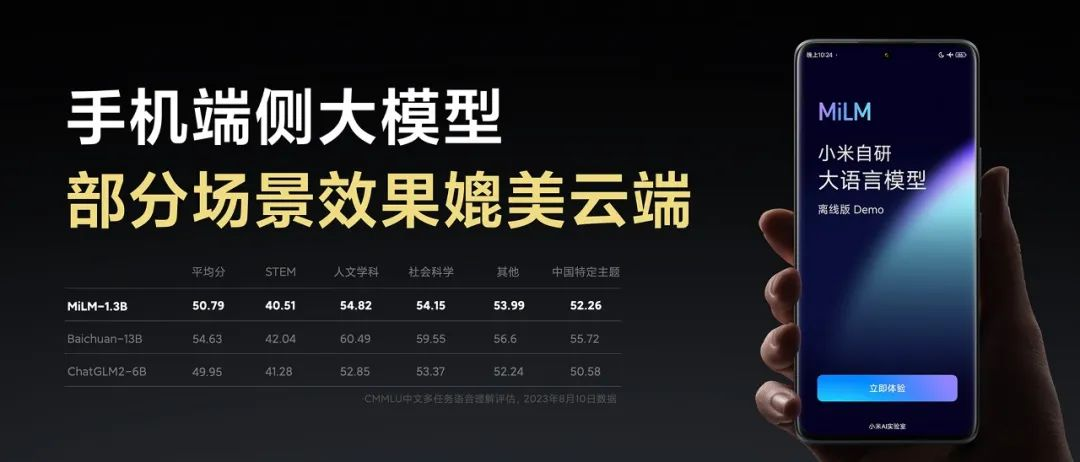
The Xiaomi large model team, led by Luan Jian, reported to Dr. Wang Bin, the director of the AI Laboratory of the Xiaomi Group's Technical Committee. The research and development started in April this year, and in just 4 months, they have already achieved remarkable results.
First, let's look at the evaluation results:
The 6B parameter version ranked first in the C-EVAL authoritative list with the same parameter level, and the Chinese multimodal language understanding (CMMLU) large model also achieved first place.

Specifically, the C-EVAL dataset is a comprehensive Chinese basic model evaluation dataset covering 52 subjects and four levels of difficulty.

The CMMLU dataset is a comprehensive Chinese evaluation benchmark specifically designed to assess the knowledge and reasoning abilities of language models in the Chinese context. CMMLU covers 67 topics ranging from basic subjects to advanced professional levels.
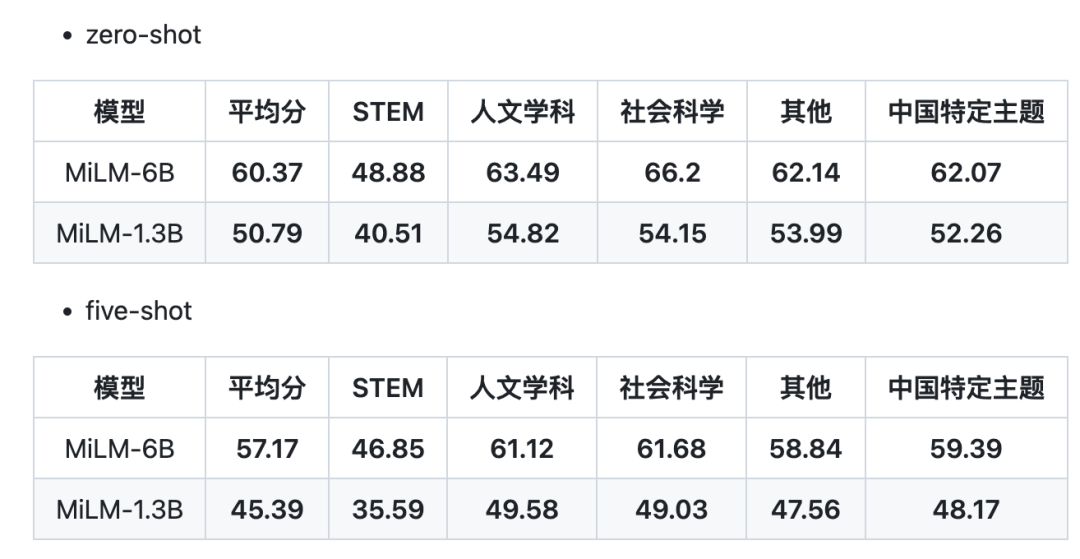
Since the arrival of ChatGPT last November, the first to take action were mostly cloud computing companies such as Microsoft, Google, and Amazon.
But as the technology matured, edge-side large models became the next focus for the industry. There have been rumors about Apple, and Xiaomi has taken the lead in the first echelon.
What are the benefits of fitting large models into smartphones?
First, local operation eliminates concerns about poor signals or lack of network on airplanes, and it also provides faster response times.
At the same time, user privacy is better protected, and it is easier to provide more personalized services.
In summary: enjoy the advanced productivity brought by AI anytime, anywhere.
At the same time, Quantum Bit has also obtained the qualification to test the new version of Xiao Ai.
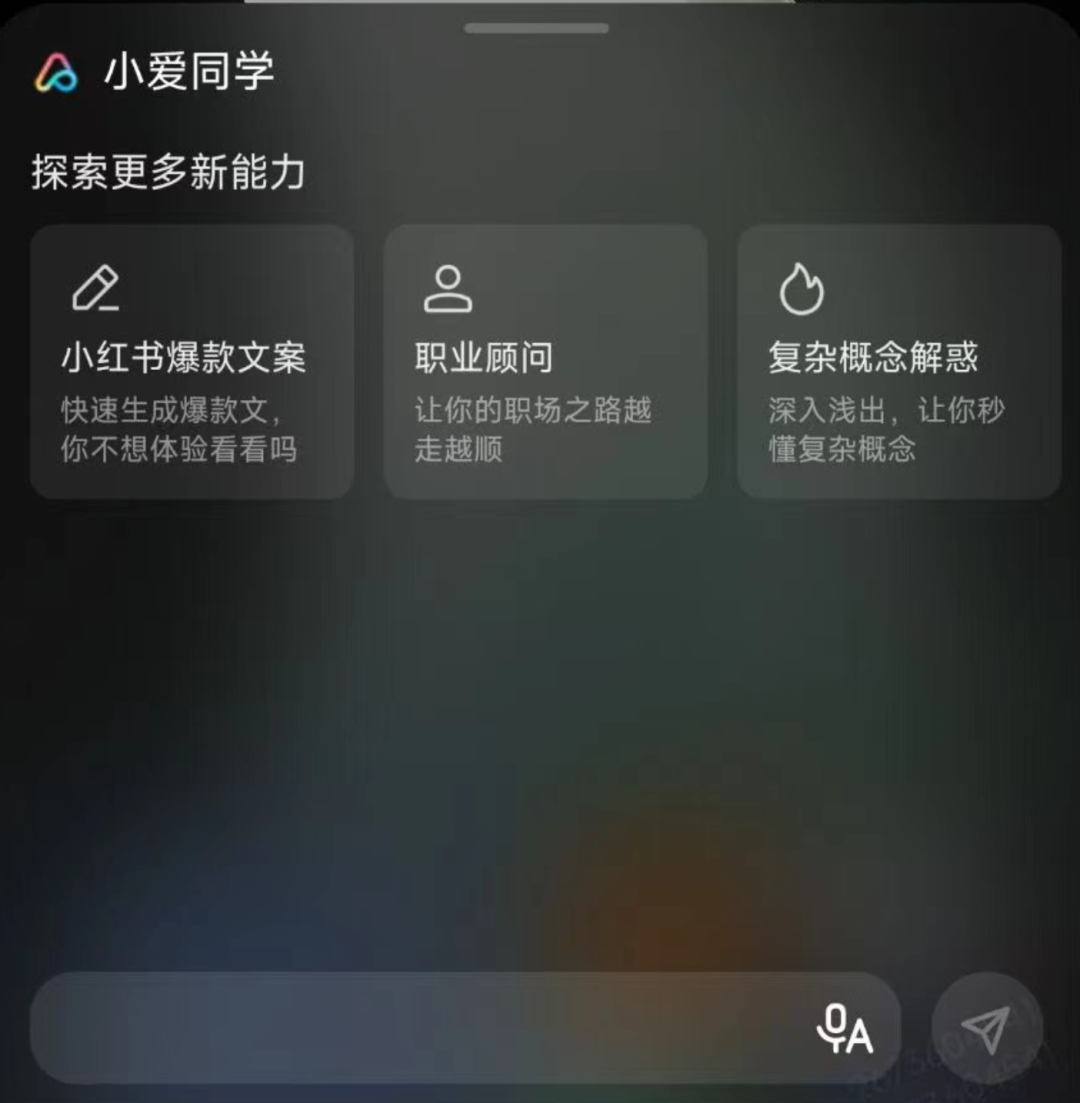
It's still the familiar voice, but with the addition of the large model, Xiao Ai has truly evolved into an intelligent assistant.
It's not a problem for Xiao Ai to explain the recent hot concept of superconductivity based on its capabilities.
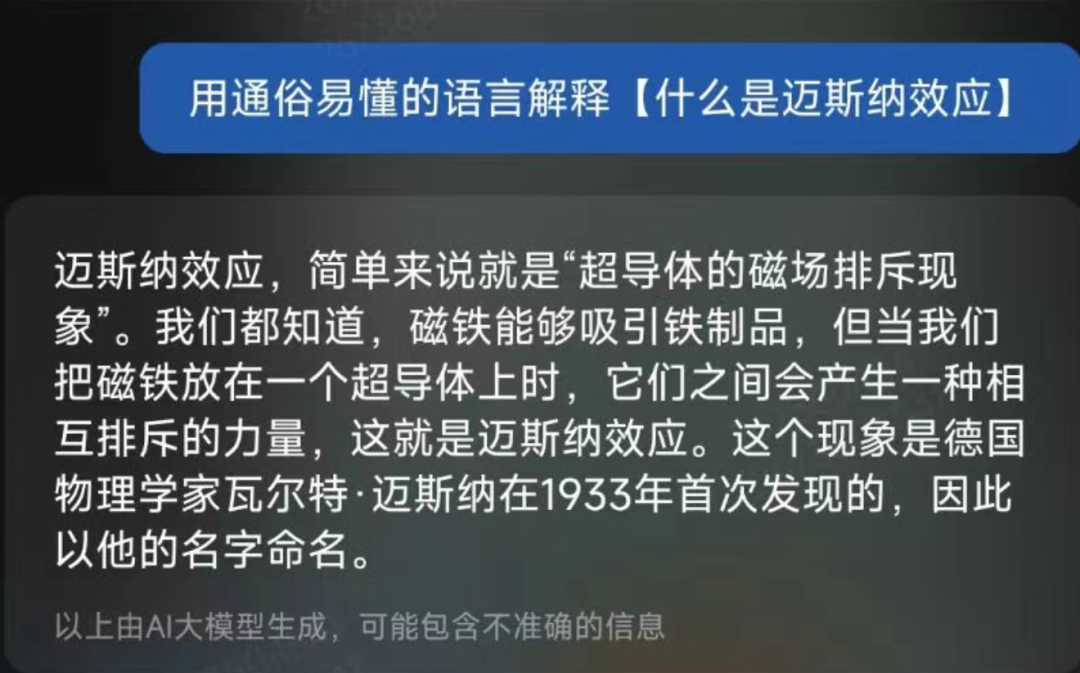
Do you remember the seemingly simple but actually difficult question that stumped many large models, "Why weren't I invited to my parents' wedding"?
Xiao Ai says it's not falling for that.
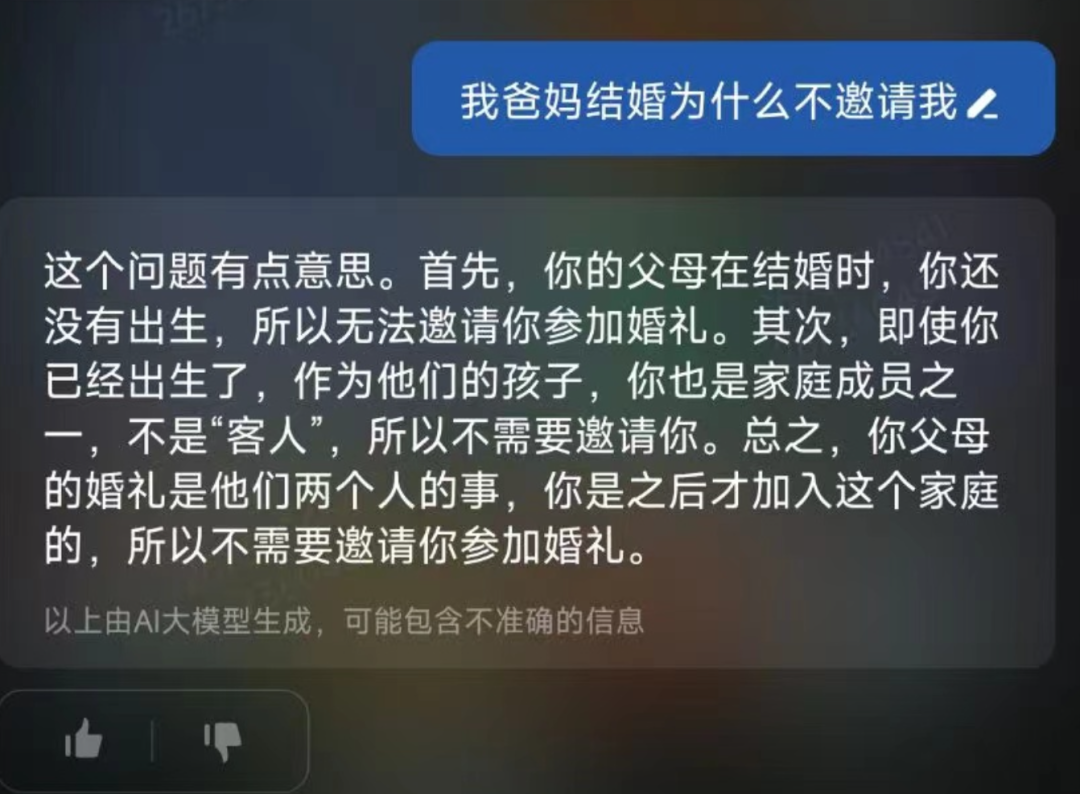
If you're not sure about the other capabilities of Xiao Ai's large model, you can also visit the exploration zone for inspiration.
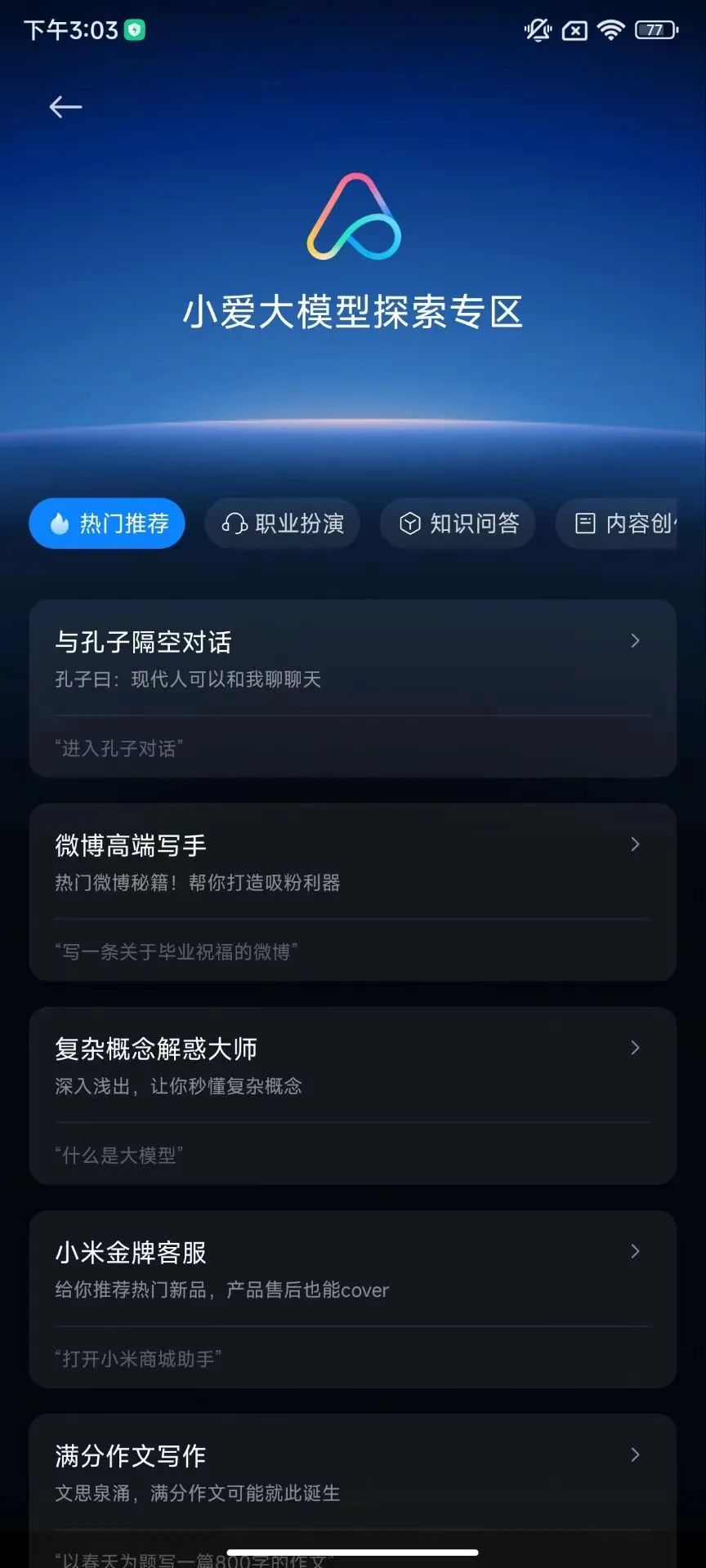
From here, it can also be seen that Xiao Ai's large model has been integrated to a certain extent with the system.
For example, in the Xiaomi gold medal customer service mode, the newly launched flagship foldable phone is introduced in detail and can be accessed with a single click to the store.
According to Xiaomi, fitting large models into smartphones is aimed at system-level capabilities, and perhaps the entire smartphone operating system will evolve into an "intelligent operating system" in the future.
However, large models in smartphones are not the only focus of Xiaomi's AI efforts. The second-generation robot dog, Iron Egg, which was also unveiled this time, hides many AI secrets.
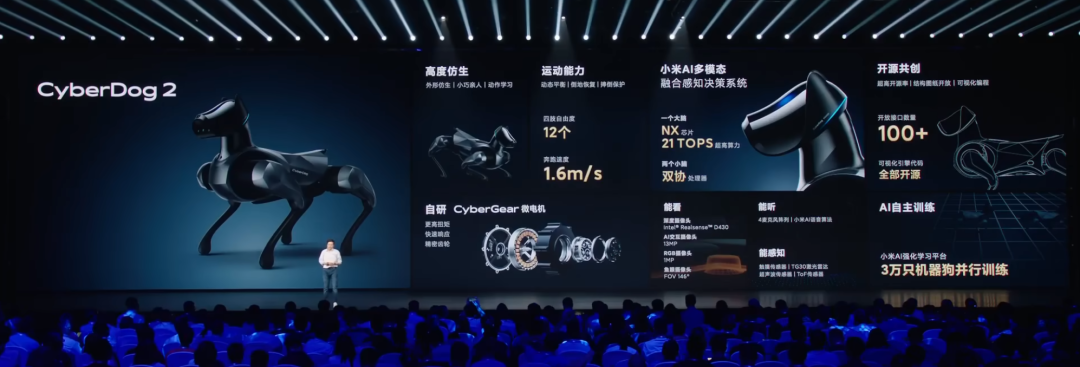
Why is the second-generation Iron Egg smaller in size and more agile than the first generation?
Behind this is Xiaomi's self-developed CyberGear force-controlled micro motor, which, through AI algorithms, optimizes the performance of the motor while reducing its weight by 20%.
In terms of behavior, in order to be more biomimetic, Xiaomi also simulated the actions of real dogs in the Xiaomi robot reinforcement learning platform, with 30,000 robot dogs undergoing parallel training.
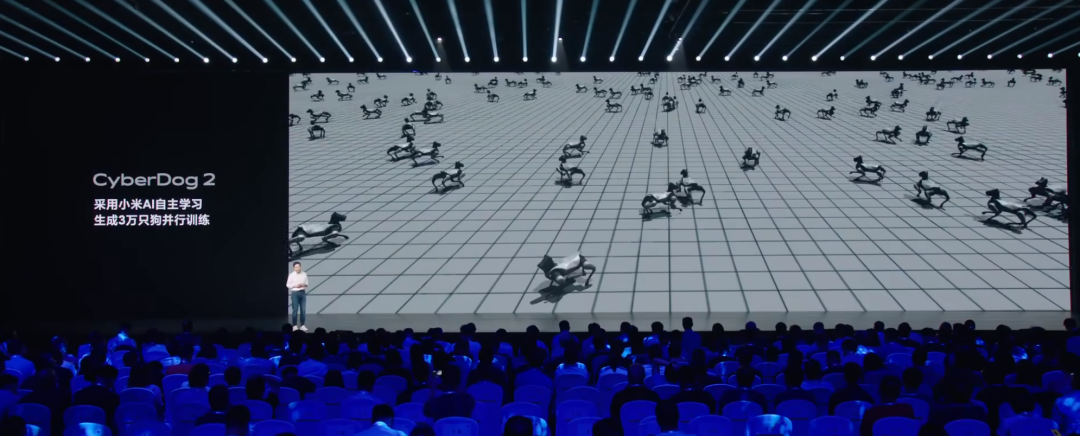
AI technology leaving the purely virtual environment and coming to smartphones, robot dogs, and potentially more smart home devices is not just a form of "empowerment," but also a way to discover new innovative optimization directions.
In the past, we have seen that the voice interaction technology of Xiao Ai on the robot dog is quite different from that of smartphones and smart speakers.
The robot dog itself moves and often appears in environments with high outdoor noise, which places higher demands on speech recognition and noise reduction algorithms, thereby driving the evolution of the algorithms.
In the future, language large models and multimodal large models will also encounter similar situations, ultimately internalizing the characteristics required by new application scenarios into the models themselves.
This is also one of the most important new directions in embodied intelligence that the academic community is exploring after large models.

We can see that at this year's Xiaomi conference, the proportion of AI is significantly higher than just the new models.
For deeper thinking behind this, Lei Jun started with a formula.

Xiaomi's Technology Strategy: Why the Emphasis on AI?
In Xiaomi's (Software × Hardware) AI formula, there is an implicit meaning:
AI is the most critical variable, and it can bring about exponential changes.
This further demonstrates Xiaomi's emphasis on AI.
The reasons behind this are not difficult to understand. By combining the development trends of AI itself and the dynamics of the terminal market where Xiaomi operates, the answers can be found.
First, let's look at the AI field.
The reason why the large model trend is so significant is that it has a profound impact on the underlying technology and industry applications.
On the one hand, the emergence of ChatGPT has verified that when the model scale exceeds a certain level, intelligent emergence occurs. This characteristic allows large models to have the ability to "generalize from one instance to another," further making it possible for AI applications to be scaled and commercialized.
At the same time, ChatGPT and Stable Diffusion are also driving AI towards generative directions. When AI has more creativity, the way humans interact with machines will also change. The most direct manifestation is that when intelligent assistants are integrated with large models, it can promote the development of more natural and convenient language communication in human-machine interactions.
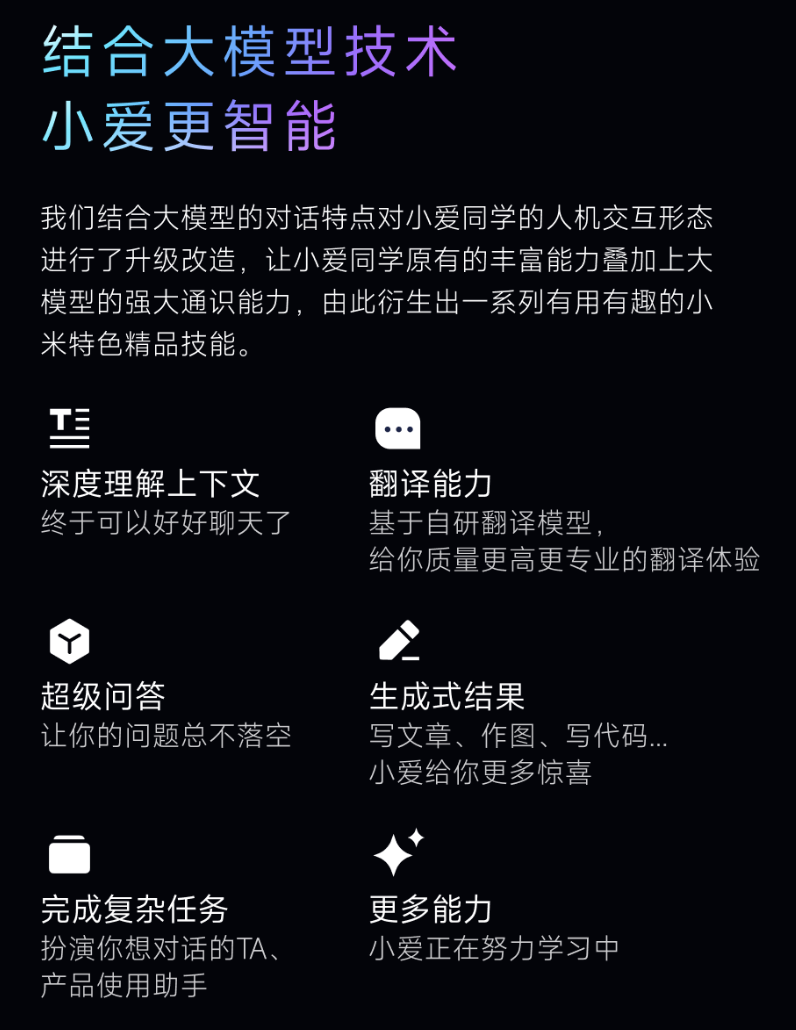
On the other hand, ChatGPT has sparked global discussions, rapidly breaking through the concept of AI and entering the awareness of various industries and the general public, accelerating the commercialization and implementation of AI applications.
The industry generally believes that industry large models built on top of basic large models will become a major component of the future large model market and one of the main drivers of practical applications.
In the past six months, manufacturers have been actively promoting and collaborating with the industry in the large model field. In vertical domains, players using large models as the underlying technology have begun to emerge, such as InflectionAI—a chatbot company focused on emotional companionship with a valuation of $4 billion.
Through these latest trend changes, it is easy to feel a fact—
AI, as a fundamental, basic, and core technology, is rapidly transforming the current era.
In past technological cycles, the representative technologies that could assume such a role were steam technology, electric power, and computers.
In other words, today's AI, like them, can become a future productivity driver, bringing about exponential growth.

So, how to make good use of this future productivity has become the most concerning issue in various industries.
Taking the terminal market where Xiaomi operates as an example, the trend of large models is evolving here.
Now, the integration of large models into smartphones has become a "big move" for many manufacturers.
It not only combines intelligent assistants with cloud-based large models but also vigorously explores edge-side models based on its own scenarios.
For example, Google's PaLM 2, which is seen as a benchmark for GPT-4, introduced the smallest "gecko" version at its launch, which can run quickly on mobile devices, including offline, and process 20 tokens per second.
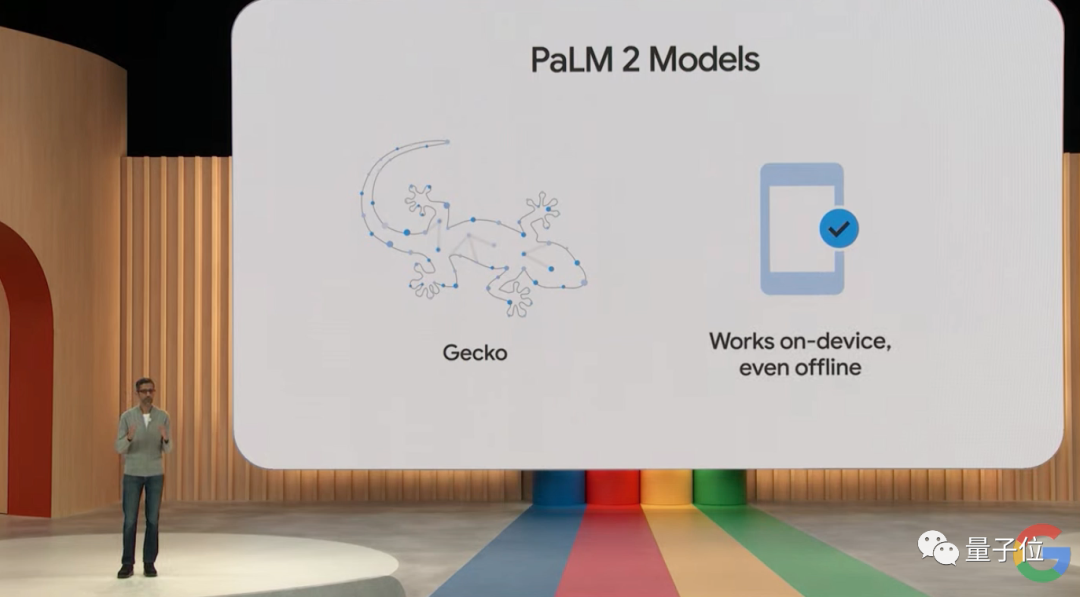
At a more fundamental chip level, preparations are also being made for the deployment of large models on the edge.
Currently, Qualcomm can apply Stable Diffusion at speeds of 15 steps and 20 steps of inference on smartphones equipped with the second-generation Snapdragon 8 mobile platform, generating 512×512 pixel images.
This reflects that large models and mobile terminals are moving in both directions.
For large models, the mobile scenario provides the richest and broadest mobile applications, being the closest screen to the general public, and is a key area for accelerating the landing of large models. Therefore, in order to adapt to the mobile scenario, more lightweight and deployable models must appear.
For smartphones, large models are accelerating the reconstruction of mobile applications and transforming human-machine interactions, which will definitely impact the smartphone industry. In the face of radical changes, seizing the trend can lead to new growth momentum. Therefore, embracing large models is inevitable for smartphone and terminal manufacturers.

In summary, it is not difficult to understand why AI content is so high in Xiaomi's latest developments.
Whether it is the launch of the large model version of Xiao Ai or the release of self-developed edge-side models, they are the results of embracing trends from Xiaomi's own perspective.
In his personal speech this year, Lei Jun proposed the formula (Software × Hardware) AI, which further reveals Xiaomi's current understanding of the latest AI trends.
This year, Lei Jun's annual speech theme was "growth." In his three-hour speech and annual new product release, he shared several key growth experiences and insights from the past 30 years.
Correspondingly, in this year that will definitely be marked in the history of AI development, Xiaomi has also reached a new key point—
Xiaomi Group announced a technology strategy upgrade, released its technology philosophy, and clarified its principles for technology exploration.
And in these new changes, the content of AI is very high.
AI Becomes the Key Variable for the New Xiaomi
In Xiaomi's latest upgraded technology strategy, four principles have been established:
- Deep cultivation of underlying technology
- Long-term continuous investment
- Deep integration of software and hardware
- Comprehensive empowerment of AI
Overall, this conveys a message: AI will become the key variable for the new Xiaomi.
In fact, both internally and externally, Xiaomi is directly born into the trend of the latest AI wave.
First, the transformation brought about by the latest AI wave is naturally compatible with Xiaomi's technological layout and strengths.
In 2016, when AlphaGo emerged and further popularized the concept of AI, Xiaomi established its first AI team.
At that time, in the AI trend, rapid development was seen in the fields of deep learning and computer vision, which was not only reflected in basic algorithms but also in application landing. For example, the four leading AI companies in China all started with computer vision.
The first AI team established by Xiaomi also anchored in the field of computer vision.
Then in 2017, "Attention is all you need" arrived.
The emergence of the Transformer architecture not only directly promoted the development of the NLP field but also had an impact on the fields of computer vision, speech, and is the core underlying technology of today's AIGC trend—most large models on the market are based on the Transformer architecture.
That year, Xiaomi made bigger moves in the field of AI, officially establishing an AI laboratory, with a comprehensive layout covering acoustics, speech, NLP, knowledge graphs, and even large models.
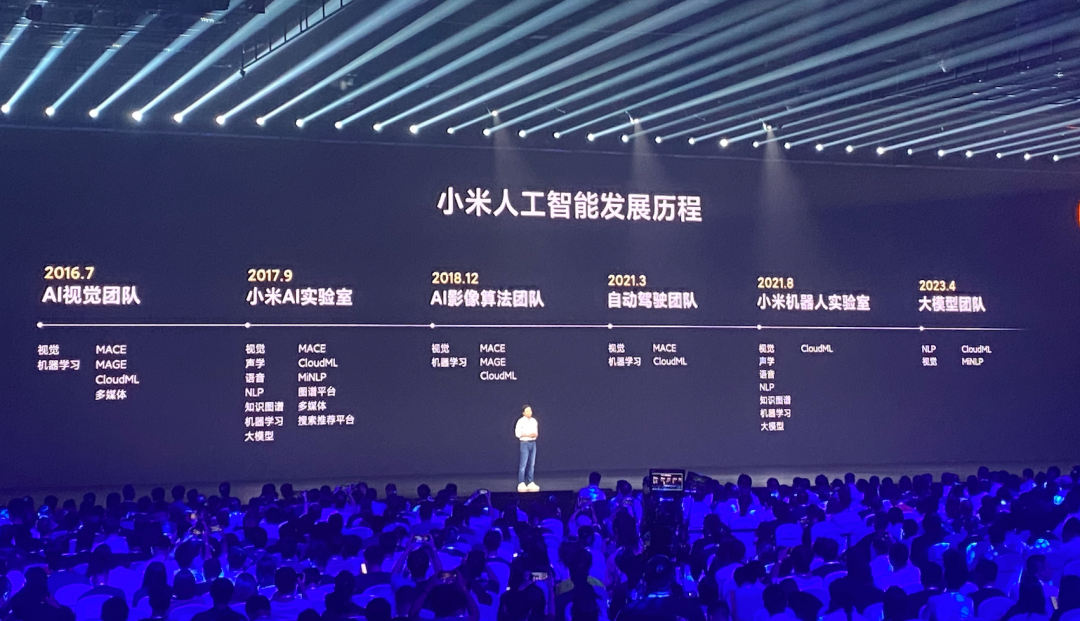
In the following years, with a solid foundation in underlying algorithms, the pace of application landing in the industry has accelerated, especially in rapidly advancing subfields.
Looking at the mobile scenario, two typical examples are intelligent assistants and AI imaging.
They both need to be deeply integrated with products to achieve further exploration. In this regard, Xiaomi has a layout and can be said to have strengths.
The latest version of Xiao Ai, which was comprehensively upgraded this time, was born six years ago and applied Xiaomi's NLP technology, accumulating a massive amount of scenario training data for the integration of large models. In terms of AI imaging algorithms, Xiaomi also established a dedicated team, and the "Night Owl algorithm" has been applied to mature products.
In April of this year, the Xiaomi large model team was quickly established, completing the latest expansion under the trend. As of now, the scale of Xiaomi's AI team has exceeded 3,000 people.
So, Xiaomi was born into the wave of AI large models, and the accumulation and preparation have long been completed. What is needed is to use the good steel to "cut" and gather resources to achieve greater breakthroughs.
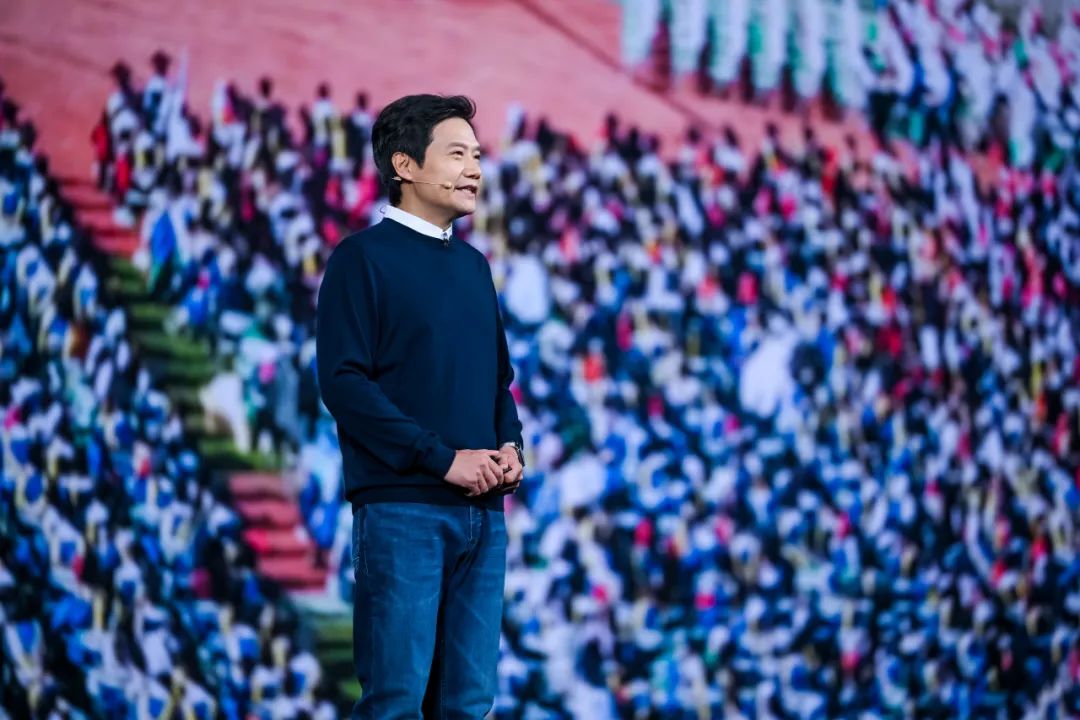
Second, the strength of Xiaomi's technology is naturally based on the natural advantages of Xiaomi's business and products, and both the upper and lower levels of Xiaomi have keenly perceived this trend.
On the one hand, technology needs to be deeply integrated into the scene to unleash greater value.
Not to mention the hottest concept today, "large models," which started as early as 2017, but the AI research community has mainly focused on benchmarking academic indicators and evaluation rankings and has not caused much of a stir.
It wasn't until ChatGPT emerged to directly address ordinary consumers that it opened up the application scenarios for chatbots and intelligent assistants, and the subsequent explosive growth of AI almost transformed every industry.
Xiaomi has been a practitioner of this concept for many years. This is also why the newly proposed formula, (Software × Hardware) as the base.
Xiaomi's scenes naturally start from the integration of software and hardware. For example, the intelligent assistant Xiao Ai has over 110 million monthly active users and supports more than 5,900 smart devices.
In terms of multiple terminals, "the smartphone is the foundation, and IoT is the imagination space" is how many people describe Xiaomi.
In the main battlefield of smartphones, Xiaomi has established its position based on the integration of software and hardware. In terms of AIoT, Lei Jun saw the trend of smart hardware and the Internet of Things as early as 2013 and became the first to define AIoT smart life.
In 2021, Lei Jun personally led Xiaomi's foray into the automotive industry, completing Xiaomi's full-scenario smart ecosystem construction with the addition of smart electric cars.
Even in the field of bionic robots, Xiaomi has now launched two generations of CyberDog and humanoid robot CyberOne, laying the groundwork for future home scenarios.
On the other hand, technology needs to be deeply integrated into the scene to have the space for fusion and evolution.
For example, the widely praised "omni-focus" feature on Xiaomi smartphones was originally based on the "owner tracking" technology of the CyberDog robot; Xiaomi's rapid progress in autonomous driving is due to the establishment of the Xiaomi Artificial Intelligence Laboratory in 2017; similarly, many technologies in the autonomous driving department have been applied to CyberOne, forming the brain of the bionic robot.
And under the latest trend of large models, scenarios such as smartphones and bionic robots are widely discussed landing scenarios.
It is precisely Xiaomi's rich scenes that make the application and iteration of AI technology more anticipated. After all, the origin of AI, whether it is deep learning algorithms or the current paradigm of large models, the most core competitive advantage behind it is based on iterative data. And Xiaomi's scenes, terminals, and data volume are all excellent guarantees for the landing and experience of AI technology.
And let's not forget, Xiaomi also has the most reliable guarantee for AI iteration—Mi Fans.
After the amazing debut of ChatGPT, the reinforcement learning mechanism based on human feedback has been repeatedly mentioned, and no player has more methodology and discourse power than Xiaomi in this critical mechanism.

Finally, the most crucial reason why AI will definitely refresh Xiaomi is the determination.
This determination is not only a historical lesson for Xiaomi's technological foundation and R&D investment but also the unwavering commitment to technology from Lei Jun, who has a background as a programmer.
All along, Xiaomi's product experience has been so strong that it has forced technology to "pale." As a result, many people have overlooked the strength of Xiaomi's technology and its comprehensive layout.
So, "the new Xiaomi" does not mean that Xiaomi is just beginning to change, but rather that it is better showcasing the continuous efforts it has made in technological innovation.
At the speech by Lei Jun, he specifically emphasized that Xiaomi's technology research and development has laid out 12 technology fields, including 5G mobile communication technology, big data, cloud computing, and artificial intelligence, and has entered smart manufacturing, robotics, unmanned factories, intelligent electric vehicles, covering 99 sub-segments.
Lei Jun revealed that as of March 31, 2023, Xiaomi's global authorized patents exceeded 32,000. Among them, in the global patent family enterprise ranking of essential 5G standard patents declared by the China Academy of Information and Communications Technology, Xiaomi's global patent family accounted for 4.1%, entering the top ten for the first time—making it the youngest player.
免责声明:本文章仅代表作者个人观点,不代表本平台的立场和观点。本文章仅供信息分享,不构成对任何人的任何投资建议。用户与作者之间的任何争议,与本平台无关。如网页中刊载的文章或图片涉及侵权,请提供相关的权利证明和身份证明发送邮件到support@aicoin.com,本平台相关工作人员将会进行核查。




